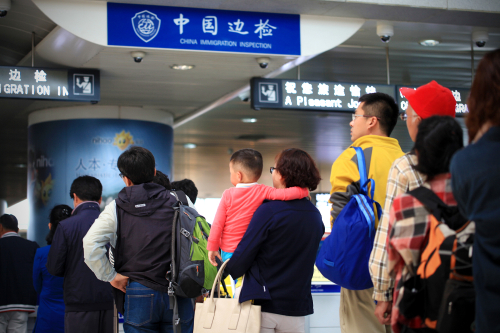 |
|
HOME SWEET HOME: Chinese citizens returning from overseas trips wait in line at customs in Qingdao, Shandong Province, on April 30 (XIE HAO) |
Fewer incoming tourists
Inbound travel to China's mainland has been stagnant in recent years.
On October 23, the NTA published data for inbound travel in the first nine months of this year. The period recorded a total of 94.65 million trips made by inbound tourists, including 75.43 million trips made by residents of Hong Kong, Macao and Taiwan and 19.21 million trips by visitors from foreign countries.
Of all foreign visitors, 11.82 million were from Asia, 4.09 million from Europe, 2.28 million from North America and the rest from other regions.
On October 20, the CTA also published a report reviewing inbound tourism in 2013. Last year, inbound tourists made a total of 120.08 million trips to China, down 2.51 percent from the previous year, the report said.
Inbound tourists generated total revenue of $51.66 billion in the year, up 3.27 percent from the previous year.
Those visiting mainly came to China to learn about the culture and do sightseeing. Beijing, Xi'an, Shanghai, Guilin, Guangzhou and the Three Gorges Dam were major destinations, the report said.
Compared to the number of inbound visitors in 2013, this year 102.78 million were from Hong Kong, Macao and Taiwan, and 26.29 million were from foreign countries.
Last year, the top 10 largest sources of inbound tourists were South Korea, Japan, Russia, the United States, Viet Nam, Malaysia, Mongolia, the Philippines, Singapore and Australia.
More than 70 percent of inbound tourists spent $501-3,000 on their trips, the CTA report said.
In 2013, per-capita spending of Chinese traveling overseas was almost three times that of foreign tourists spent in China, Fan Zhiyong, an associate professor with the School of Economics of Renmin University of China, told Xinhua News Agency.
Dai said that the generally lackluster world economy and increase in the competitiveness of neighboring countries has contributed to the stagnation in China's inbound tourism. Heavy smog and concern over food safety has also held some foreign travelers back.
Nonetheless, he believes a main reason is the inability of the country's tourism industry to adapt to new trends in international travel.
He said that competition between tourist destinations used to be in tourism resources, products, images and management, while now it is gradually shifting toward the social environment, the country's image, and management of diversified tourist flows.
He said that major tourist destination countries and regions have implemented comprehensive policies to promote the development of inbound tourism, such as easing visa procedures and launching promotional campaigns.
Dai suggested that China's tourism industry should jump out of the box and reorient toward tourists.
In 2014, the NTA launched a number of advertising campaigns overseas, including "Beautiful China—Rediscover the Silk Road" and "Journey Along the Great Wall," the promotional website Cn.travelchina.gov.cn, as well as Facebook and Twitter accounts.
The fact that outbound tourism has outgrown inbound tourism should not be a surprise, said Liu Simin, a researcher with the Tourism Research Center under the Chinese Academy of Social Sciences.
He said that inbound and outbound tourism in China are in different life phases. Inbound tourism started in China after the implementation of the reform and opening-up policy in the late 1970s, and now has history of more than 30 years, whereas outbound tourism started around the year of 2000.
When China had just opened up, it was a new destination for foreigners, so although it did not have good facilities, foreigners flocked into the country, Liu said. Now, China is becoming more and more international, and foreigners are no longer as curious, he said. However, curiosity about the outside world is prompting more and more Chinese to go abroad.
Email us at: yinpumin@bjreview.com | 